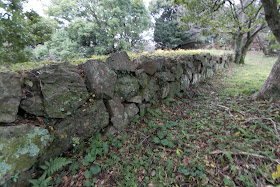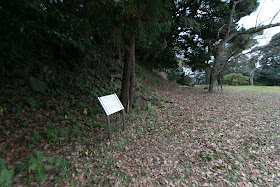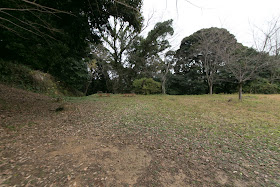Hamada Castle
-Gone with the Edo shogunate-
Overview
Name: Hamada castle (Hamada-jo)
Alias: Kameyama-jo (Turtle mountain castle)
Place: Tonomachi Hamada city, Shimane
Location: 34.90337724864608, 132.0735674611482
Type: Hill castle
Built: 1623
Remaining remnants: Stone walls, clay walls and dry moats
Title: 100 more famous Japanese castles
Hamada castle (浜田城) is located on Kameyama hill, at the mouth of Hamada river and beside Sanindo road. Hamada city has been a central city of Iwami province (western Shimane prefecture) historically. The city has a good port and is a posting site of Sanindo road.
In 1600, as a result of battle of Sekigahara, the territory of Mouri clan which formerly goverened Suo province and Nagato province (Yamaguchi prefecture), Iwami province and Aki province (Hiroshima prefecture) was decreased only to Suo province and Nagato province by Edo Shogunate.
Instead of Mouri clan, once Sakazaki clan which was the lord of Tsuwano castle reigned Hamada area, but in 1619 Furuta clan which was the lord of Matsusaka castle (Mie prefecture) was appointed to govern Hamada city. Furuta clan newly built a castle on the hill and named it as Hamada castle in 1623.
Hamada castle was a small castle built over a hill of about 60 meter height which spreads 300 meter long and 100 meter wide. As formerly this hill projected to the sea like a peninsula, it was necessary to protect only front side of the castle. Even though a small one, it was secured by fully built stone walls different from medieval castles.
Central area of the castle is about 100 meter long square shaped area, which was surrounded by stone walls. At the northwestern corner a three story main tower was built, but it was built directly on the ground of main area and only keystones remain around the area. At the southern line, there was a magnificent masugata style gate with buffer area,
In front of central area, there are several terraces which separated by stone walls and have a folded path for defense. This complex of small terraces resembles to Matsusaka castle, former base base of Furuta clan. Now a broad slope connected outer area and inner area but it might be a reform of later period and originally the entrance road only passed gate area.
According to imaginary CG picture, even though having only limited building including main tower and several gates, this castle has a magnificent view utilizing the height of hill and lines of stone walls. Including outer area, total size of the castle mighte be 300 meter long and 200 meter wide.
Furuta clan was expelled in 1648 by internal conflict, then Hamada castle became a front fort of Edo Shogunate against Choshu domain of Mouri clan then hereditary retainers of Shogunate were appointed as the lord of the castle. Esoecukkat in 1847, Takeakira Matusdaira (1842-1884), the younger brother of 15th Shogun Yoshihobu Tokugawa (1837-1913), was appointed as adopted as a lord.
In 19th century, after the arrival of Amerilan Admiral Matthew C. Perry to Japan to force opning nation to foreign country in 1853, public opinion became split concerning the this matter. Edo shogunate decided to open the nation considering foreign millitary power, but large local lords such as Choshu domain (Mouri clan) and Satsuma domain (Shimazu clan) opposed to the opening under the intention of current emperor Komei, and performed anti-shogunate activities.
To punish Choshu domain, shogunate made expeditions to Choshu territory by surrounding local lords including Hamada domain in 1861 and 1862 twice. For first expedition, it was just after the attack to Choshu domain by ally of English, French, Dutch and American navy as a revenge to killing foreigner and shutiing the Kanmon straight. Due to that damage, Choshu domain once surrendered to shogunate before the beginning of battle, and killed its activists.
But Shogunate imposed too severe surrender conditions, thus Choshu domain decided to a do-or-die resistance to Edo shogunate again in 1865. This time Choshu domain made peace with Britain and acquired their new weapons, and Satsuma domain also supported Choshu clan. On the other hand, Shogunate side army had only low moral because of continuous marches, and their equipment were old ones. Shogunate army attacked Choshu territory from their four borders, but they were all in deadlock or driven away facing Chushu armies and militias equipped by new weapons.
Hamada clan attacked Choshu domain by northeastern border of Choshu territory, but suffered severe defeat by them and retreated. Choshu domain army chased Hamada domain army and intruded into Hamada town.
As Hamada castle was a small castle without secure defense facility, Hamada domain burnt down Hamada castle by themselves and escaped. Next year shogunate army lost the battle of Toba Fushimi against new government force consisted of Choshu clan and Satsuma clan, and finally in 1867 Edo shogunate returned its government to the Emperor.
Subsequent to Meiji revolution outer area disappeared into the city, but stone walls of major areas on the hill still remain well. Broken pieces of roofing tiles spread over the castle, and shows the vivid image of disposal. Now one gate formerly used at Tsuwano castle (Shimane prefecture) is moved to entrance of this castle.
20 minutes walk from JR West Sanin-Honsen line Hamada station. 15 minutes drive from Hamada Jidoshado Expressway Hamada interchange.
Tsuwano Castle -Broken promises-
Matsusaka Castle -Castle of magnificent stone wall built by brave and wise general-
Type: Hill castle
Built: 1623
Remaining remnants: Stone walls, clay walls and dry moats
Title: 100 more famous Japanese castles
Brief History
Build of Hamada castle
In 1600, as a result of battle of Sekigahara, the territory of Mouri clan which formerly goverened Suo province and Nagato province (Yamaguchi prefecture), Iwami province and Aki province (Hiroshima prefecture) was decreased only to Suo province and Nagato province by Edo Shogunate.
Instead of Mouri clan, once Sakazaki clan which was the lord of Tsuwano castle reigned Hamada area, but in 1619 Furuta clan which was the lord of Matsusaka castle (Mie prefecture) was appointed to govern Hamada city. Furuta clan newly built a castle on the hill and named it as Hamada castle in 1623.
Structure of Hamada castle
Hamada castle was a small castle built over a hill of about 60 meter height which spreads 300 meter long and 100 meter wide. As formerly this hill projected to the sea like a peninsula, it was necessary to protect only front side of the castle. Even though a small one, it was secured by fully built stone walls different from medieval castles.Central area of the castle is about 100 meter long square shaped area, which was surrounded by stone walls. At the northwestern corner a three story main tower was built, but it was built directly on the ground of main area and only keystones remain around the area. At the southern line, there was a magnificent masugata style gate with buffer area,
In front of central area, there are several terraces which separated by stone walls and have a folded path for defense. This complex of small terraces resembles to Matsusaka castle, former base base of Furuta clan. Now a broad slope connected outer area and inner area but it might be a reform of later period and originally the entrance road only passed gate area.
According to imaginary CG picture, even though having only limited building including main tower and several gates, this castle has a magnificent view utilizing the height of hill and lines of stone walls. Including outer area, total size of the castle mighte be 300 meter long and 200 meter wide.
First expedition to Choshu domain
Furuta clan was expelled in 1648 by internal conflict, then Hamada castle became a front fort of Edo Shogunate against Choshu domain of Mouri clan then hereditary retainers of Shogunate were appointed as the lord of the castle. Esoecukkat in 1847, Takeakira Matusdaira (1842-1884), the younger brother of 15th Shogun Yoshihobu Tokugawa (1837-1913), was appointed as adopted as a lord.
In 19th century, after the arrival of Amerilan Admiral Matthew C. Perry to Japan to force opning nation to foreign country in 1853, public opinion became split concerning the this matter. Edo shogunate decided to open the nation considering foreign millitary power, but large local lords such as Choshu domain (Mouri clan) and Satsuma domain (Shimazu clan) opposed to the opening under the intention of current emperor Komei, and performed anti-shogunate activities.
To punish Choshu domain, shogunate made expeditions to Choshu territory by surrounding local lords including Hamada domain in 1861 and 1862 twice. For first expedition, it was just after the attack to Choshu domain by ally of English, French, Dutch and American navy as a revenge to killing foreigner and shutiing the Kanmon straight. Due to that damage, Choshu domain once surrendered to shogunate before the beginning of battle, and killed its activists.
Fail of second expedition and fall of castle
But Shogunate imposed too severe surrender conditions, thus Choshu domain decided to a do-or-die resistance to Edo shogunate again in 1865. This time Choshu domain made peace with Britain and acquired their new weapons, and Satsuma domain also supported Choshu clan. On the other hand, Shogunate side army had only low moral because of continuous marches, and their equipment were old ones. Shogunate army attacked Choshu territory from their four borders, but they were all in deadlock or driven away facing Chushu armies and militias equipped by new weapons.
Hamada clan attacked Choshu domain by northeastern border of Choshu territory, but suffered severe defeat by them and retreated. Choshu domain army chased Hamada domain army and intruded into Hamada town.
As Hamada castle was a small castle without secure defense facility, Hamada domain burnt down Hamada castle by themselves and escaped. Next year shogunate army lost the battle of Toba Fushimi against new government force consisted of Choshu clan and Satsuma clan, and finally in 1867 Edo shogunate returned its government to the Emperor.
Subsequent to Meiji revolution outer area disappeared into the city, but stone walls of major areas on the hill still remain well. Broken pieces of roofing tiles spread over the castle, and shows the vivid image of disposal. Now one gate formerly used at Tsuwano castle (Shimane prefecture) is moved to entrance of this castle.
Access
20 minutes walk from JR West Sanin-Honsen line Hamada station. 15 minutes drive from Hamada Jidoshado Expressway Hamada interchange.
Related Castles
Tsuwano Castle -Broken promises-
Matsusaka Castle -Castle of magnificent stone wall built by brave and wise general-





















































































































































No comments:
Post a Comment